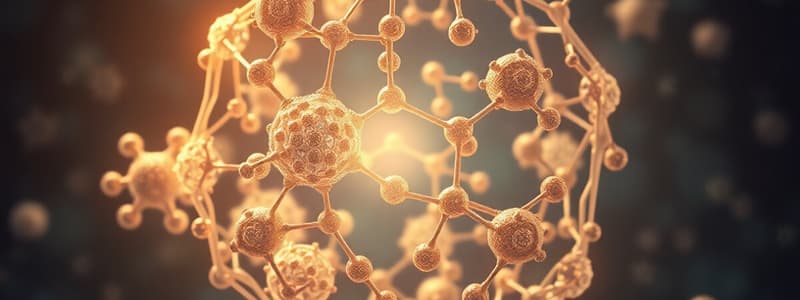Podcast
Questions and Answers
What are the basic units of matter and what determines their chemical properties?
What are the basic units of matter and what determines their chemical properties?
Atoms are the basic units of matter, and their chemical properties are determined by the arrangement of protons, neutrons, and electrons.
Explain the difference between covalent and ionic bonds.
Explain the difference between covalent and ionic bonds.
Covalent bonds are formed by the sharing of electrons between atoms, while ionic bonds occur when one atom donates an electron to another, creating charged ions.
Why is water considered an excellent solvent in biological systems?
Why is water considered an excellent solvent in biological systems?
Water is a polar molecule, which allows it to dissolve many substances, facilitating biochemical reactions.
What role do buffers play in biological systems?
What role do buffers play in biological systems?
How do the structures of proteins and nucleic acids determine their functions?
How do the structures of proteins and nucleic acids determine their functions?
What roles do enzymes play in biochemical reactions?
What roles do enzymes play in biochemical reactions?
Differentiate between anabolic and catabolic reactions.
Differentiate between anabolic and catabolic reactions.
Explain the significance of oxidation and reduction reactions in metabolism.
Explain the significance of oxidation and reduction reactions in metabolism.
What is meant by dynamic equilibrium in biochemical reactions?
What is meant by dynamic equilibrium in biochemical reactions?
Describe how functional groups impact the reactivity of organic molecules.
Describe how functional groups impact the reactivity of organic molecules.
Flashcards
Atoms
Atoms
Basic units of matter, made of protons, neutrons, and electrons.
Covalent Bonds
Covalent Bonds
Strong chemical bonds formed by sharing electrons between atoms.
Polarity of Water
Polarity of Water
Water's uneven charge distribution, making it a great solvent.
pH Scale
pH Scale
Signup and view all the flashcards
Macromolecules
Macromolecules
Signup and view all the flashcards
Enzyme function
Enzyme function
Signup and view all the flashcards
Active site
Active site
Signup and view all the flashcards
Anabolism
Anabolism
Signup and view all the flashcards
Study Notes
Chemistry Concepts Applicable to Biological Systems
- Key chemistry concepts are essential for understanding complex biological systems
- Atoms are the basic units of matter, composed of protons, neutrons, and electrons
- Molecules are formed when two or more atoms bond together through covalent or ionic bonds
- Covalent bonds form by sharing electrons between atoms, forming the basis of organic molecules (proteins, nucleic acids, carbohydrates, and lipids)
- Ionic bonds form when one atom donates an electron to another, creating charged ions that attract each other
- Hydrogen bonds are weak attractions between polar molecules, crucial for the structure of water and biomolecules like DNA and proteins
- Water's polar nature makes it an excellent solvent for many biochemical reactions
- pH measures acidity/basicity; buffers help maintain specific pH levels in biological systems
- Macromolecules (proteins, nucleic acids, carbohydrates, lipids) play crucial roles in biological systems
Macromolecules
- Proteins are composed of amino acids linked by peptide bonds; structure determines function
- Nucleic acids (DNA and RNA) are polymers of nucleotides that store and transmit genetic information
- Carbohydrates are made of sugar molecules, serving as energy sources and structural components
- Lipids are diverse molecules including fats, oils, phospholipids, and steroids; important for energy storage, membrane structure, and signaling
Enzymes and Catalysis
- Enzymes are biological catalysts that speed up chemical reactions, lowering the activation energy
- Enzymes have an active site for substrate binding and often exhibit specificity and regulation
Metabolism
- Anabolic reactions build larger molecules, while catabolic reactions break down molecules for energy
- ATP (adenosine triphosphate) is the primary energy carrier in cells
Redox Reactions
- Oxidation and reduction reactions involve the transfer of electrons, playing critical roles in energy production and metabolism
Chemical Equilibrium
- Equilibrium is reached when the rates of forward and reverse reactions are equal
- Le Chatelier's principle describes how systems at equilibrium respond to external changes (concentration, temperature, pressure) to maintain equilibrium
Functional Groups
- Functional groups are specific groups of atoms that confer distinct chemical properties to organic molecules
Chemical Bonds (Covalent & Ionic)
- Covalent bonds form when atoms share one or more pairs of electrons (polar vs. nonpolar)
- Ionic bonds form when one atom transfers one or more electrons to another, creating ions that attract each other
Biomolecules
- Biomolecules are essential organic molecules in biological systems, playing critical roles
- Biomolecules include carbohydrates, proteins, lipids, and nucleic acids
Other Important Biomolecules
- Vitamins, hormones, and coenzymes are crucial for various biochemical functions
Studying That Suits You
Use AI to generate personalized quizzes and flashcards to suit your learning preferences.




